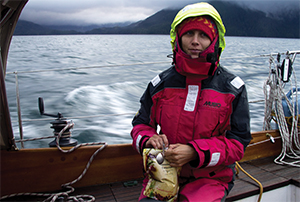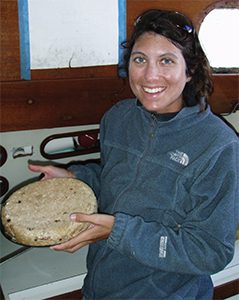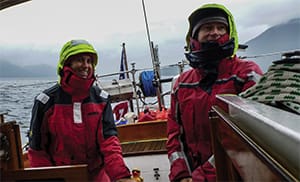To the editor: The joke about seasickness is that it has three stages: feeling terrible, worried you might die and worried you won’t die. Luckily, managing seasickness is possible.
When I was 20 and setting off to sail around world, I thought I’d be immune to seasickness. I loved the ocean, I loved sailing; I had always wanted to cross an ocean. As an amateur salt, I had also imbued the tacit belief that seasickness equals lack of character — that was my first mistake. It doesn’t. It’s a physical phenomenon brought about by the conflicting signals that your eyes and inner ear transmit to your brain. That’s not to say there’s nothing you can do about it, but the first thing you should not do is blame yourself.
My first short passages south from Maine along the East Coast went fine, but on my first longish passage (700 miles from North Carolina to the Bahamas), I discovered I was definitely not immune to le mal de mer. At first I was miserable — angry at myself that I wasn’t pulling my weight (Mistake No. 1: blaming myself), worried about my crewmates getting too tired and worried I might die as I dry-heaved yet again. But what pushed me into the “worried I won’t die” stage of seasickness was actually another member of our crew. Like me, he’d absorbed the conviction that seasickness equals lack of character, but unlike me he hadn’t learned the complete fallacy of this idea. So he berated me for five days as I drifted closer and closer to critical dehydration. That was Mistake No. 2: Don’t go offshore with people about whom you have misgivings, especially if you’re prone to motion sickness. The Merck Manual, the medical bible, underlines the fact that seasickness can be much worsened by anxiety.
 |
|
Don’t get hungry and you’re less likely to feel unsettled. |
|
Seth Leonard |
This crewmember soon left us — in fact, both our crewmembers were replaced by an uncomplaining wind vane — but it wasn’t until much later that I realized that his departure was the primary reason for my tummy’s well-being on later passages. At first I gave credit to the Scopolamine patches I began to use. These are little round patches worn just behind the ear and changed every three days, providing continuous release of the drug. After a few passages when I wore it continuously, I eased off and didn’t use it all the time, but it worked well when I did.
Then one day, anticipating nasty chop in Australia’s shallow Gulf of Carpentaria, I put on a patch and was horribly sick within hours. Almost as sick, actually, as on that first Gulf Stream passage! The seas were rough but not that bad; what could be wrong? I was hydrated, I wasn’t hungry, I didn’t make it worse by blaming myself anymore, there were no harsh words from anyone and I was wearing a Scopolamine patch. That was it, I was wearing a patch. The fine print says that it’s possible to grow hypersensitive to Scopolamine. When that happens, the effect is contraindication — the medicine has the exact opposite of its intended effect. The patch itself was making me sick.
That was Mistake No. 3. Instead of letting my body work it out, I had sought comfort in drugs designed for a short foray on the ocean — a live-aboard scuba dive trip or a week’s charter in the Virgin Islands. The drugs weren’t meant for someone like me, a live-aboard voyager. After that, I threw away all my remaining Scopolamine and I’ve never yet taken another drug, even an over-the-counter one.
 |
|
Ellen with her cinnamon-raisin bread baked on a passage to South Africa. |
|
Seth Leonard |
It’s possible that I might be too militantly anti-drug. In downright awful conditions, my husband Seth takes over-the-counter meclizine, though never for more than about 24 hours, and finds that it helps a lot without causing drowsiness. Militant or not, though, I was astonished at how quickly I adjusted when I stopped taking Scopolamine. Even with the notorious cross-swell in the southern Indian Ocean, I was reading books on my midnight watch by Day 3. I cooked and washed dishes without even feeling nauseated. I stood on the pitching coach roof to furl the main when storms forced us to run under staysail alone. I even found myself baking bread on one of the roughest passages of a westward circumnavigation, across the Agulhas Current to South Africa.
In the years since I completed my circumnavigation, I’ve continued to steer clear of seasickness drugs. And yet I’ve sailed in some fairly inclement conditions: against the wind toward Alaska’s Aleutian Islands, twice across the entire Bering Sea, and in the heart of Siberian low-pressure systems as they piled into the Alaskan Arctic coastline. Of course I still can feel really terrible, but never again have I reached the “worried I won’t die” stage.
—Writer, photographer and circumnavigator Ellen Massey Leonard sails with her husband Seth on their cold-molded cutter, Celeste.

